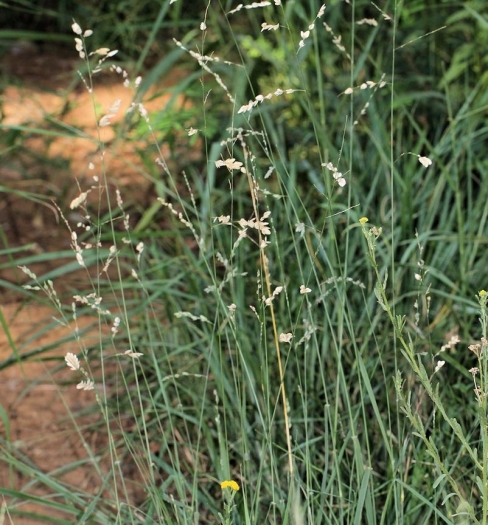Maasai Lovegrass
(Eragrostis superba)
Maasai Lovegrass (Eragrostis superba)
/
/

Wynand Uys
CC BY 4.0
Image By:
Wynand Uys
Recorded By:
Copyright:
CC BY 4.0
Copyright Notice:
Photo by: Wynand Uys | License Type: CC BY 4.0 | License URL: http://creativecommons.org/licenses/by/4.0/ | Rights Holder: Wynand Uys | Publisher: iNaturalist | Date Created: 2013-01-10T08:36:55-08:00 |





















Estimated Native Range
Summary
Eragrostis superba, commonly known as Maasai Lovegrass, is a perennial tufted grass native to a range of habitats including open woodlands, grasslands, and savannas from Sudan to South Africa. It is well-adapted to altitudes up to 4921 feet. This species typically thrives in sandy soils and is often found in areas with seasonal rainfall patterns. Eragrostis superba reaches heights of 20-70 cm and forms dense clumps of fine-textured foliage. It flowers during the rainy season, producing distinctive large, flat, oval-shaped spikelets with serrated edges. The spikelets exhibit a purple or pinkish hue when fresh, adding a subtle color to the landscape.
Maasai Lovegrass is valued for its drought tolerance and ability to grow in poor soils, making it a useful species for erosion control and soil stabilization. Its ornamental qualities include the attractive coloration of its spikelets and its fine-textured foliage, which sways gracefully in the breeze. In cultivation, it requires minimal maintenance and is suitable for xeriscaping, naturalized areas, and as a component of mixed grassland plantings. It prefers full sun and well-drained soils. While it is a valuable forage plant, it is not aggressive and occurs at low densities, reducing the risk of it becoming invasive.CC BY-SA 4.0
Maasai Lovegrass is valued for its drought tolerance and ability to grow in poor soils, making it a useful species for erosion control and soil stabilization. Its ornamental qualities include the attractive coloration of its spikelets and its fine-textured foliage, which sways gracefully in the breeze. In cultivation, it requires minimal maintenance and is suitable for xeriscaping, naturalized areas, and as a component of mixed grassland plantings. It prefers full sun and well-drained soils. While it is a valuable forage plant, it is not aggressive and occurs at low densities, reducing the risk of it becoming invasive.CC BY-SA 4.0
Plant Description
- Plant Type: Grass
- Height: 1.5-3 feet
- Width: 1-2 feet
- Growth Rate: Moderate, Rapid
- Flower Color: N/A
- Flowering Season: Spring, Summer
- Leaf Retention: Deciduous, Semi-deciduous
Growth Requirements
- Sun: Full Sun, Part Shade
- Water: Medium
- Drainage: Fast, Medium
Common Uses
Drought Tolerant, Erosion Control, Low Maintenance
Natural Habitat
Native to open woodlands, grasslands, and savannas from Sudan to South Africa
Other Names
Common Names: Sawtooth Lovegrass, Perennial Lovegrass, Wilman’s Lovegrass, Capim-Massai, Heart-Seed Grass
Scientific Names: , Eragrostis superba, Eragrostis alata, Eragrostis elata, Eragrostis elata, Eragrostis platystachys, Eragrostis superba var. contracta, Uniola jardinii,
GBIF Accepted Name: